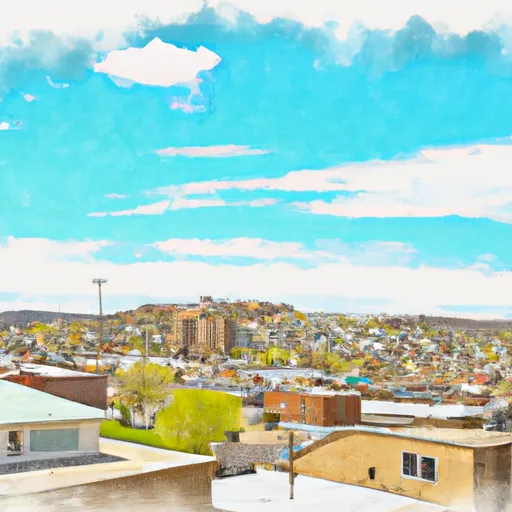-
 Snoflo Premium
Snoflo Premium
Get unlimited access to all our content
With no Ad interruptions! - Start Your Free Trial Login with existing account
Vernal
Eden Index
Climate
7.6
•
Recreation
4.2
•
Community
1.8
•
Safeguard
4.9/10

Vernal, Utah is a picturesque city located in Uintah County, in the northeastern part of the state. The climate in Vernal is characterized by hot summers and cold winters, with an average annual temperature of around 50°F (10°C). Summers can be quite hot, with temperatures frequently reaching into the 90s°F (30s°C), while winters are cold and snowy, with temperatures dropping below freezing.
Vernal is blessed with abundant hydrology constituents, thanks to the nearby Green River and numerous streams and lakes in the surrounding area. These water bodies provide opportunities for fishing, boating, and other water-based activities. The Green River offers excellent fly fishing for trout, while nearby Flaming Gorge Reservoir is known for its trophy lake trout.
Outdoor recreation is a highlight of Vernal, with a wide range of activities available. The city is surrounded by stunning natural beauty, including the nearby Uinta Mountains and Dinosaur National Monument. Hiking, camping, mountain biking, and rock climbing are popular pursuits in the area. Additionally, the region is renowned for its dinosaur fossils, offering visitors the chance to explore ancient history through guided tours and excavations. Overall, Vernal is a paradise for outdoor enthusiasts seeking adventure and natural wonders.
What is the Eden Index?
The Snoflo Eden Index serves as a comprehensive rating system for regions, evaluating their desirability through a holistic assessment of climate health, outdoor recreation opportunities, and natural disaster risk, acknowledging the profound impact of these factors on livability and well-being.
Climate Health Indicator (CHI): 7.6
Vernal receives approximately
246mm of rain per year,
with humidity levels near 69%
and air temperatures averaging around
8°C.
Vernal has a plant hardyness factor of
5, meaning
plants and agriculture in this region thrive during a short period during spring and early summer. Most
plants will die off during the colder winter months.
By considering the ideal temperature range, reliable water supplies, clean air, and stable seasonal rain or snowpacks, the Climate Health Indicator (CHI) underscores the significance of a healthy climate as the foundation for quality living.
A healthy climate is paramount for ensuring a high quality of life and livability in a region, fostering both physical well-being and environmental harmony. This can be characterized by ideal temperatures, reliable access to water supplies, clean air, and consistent seasonal rain or snowpacks.
Weather Forecast
Streamflow Conditions
Lower Green
Area Rivers
Lower Green
Snowpack Depths
Lower Green
Reservoir Storage Capacity
Lower Green
Groundwater Levels
Recreational Opportunity Index (ROI): 4.2
The Recreational Opportunity Index (ROI) recognizes the value of outdoor recreational options, such as parks, hiking trails, camping sites, and fishing spots, while acknowledging that climate plays a pivotal role in ensuring the comfort and consistency of these experiences.
Access to outdoor recreational opportunities, encompassing activities such as parks, hiking, camping, and fishing, is crucial for overall well-being, and the climate plays a pivotal role in enabling and enhancing these experiences, ensuring that individuals can engage in nature-based activities comfortably and consistently.
Camping Areas
| Campground | Campsites | Reservations | Toilets | Showers | Elevation |
|---|---|---|---|---|---|
| Greendale - Flaming Gorge | 8 | 6,998 ft | |||
| Red Fleet State Park | 31 | 5,719 ft | |||
| Greens Lake - Flaming Gorge | 20 | 7,467 ft | |||
| Oaks Park | 11 | 9,277 ft | |||
| Canyon Rim - Flaming Gorge | 15 | 7,439 ft | |||
| Red Springs | 14 | 10,483 ft | |||
| Pelican Lake | 12 | 4,815 ft | |||
| Lodgepole | 35 | 8,082 ft | |||
| Steinaker State Park | 29 | 5,560 ft | |||
| East Park | 21 | 9,050 ft |
Catastrophe Safeguard Index (CSI):
The Catastrophe Safeguard Index (CSI) recognizes that natural disaster risk, encompassing floods, fires, hurricanes, and tornadoes, can drastically affect safety and the overall appeal of an area.
The level of natural disaster risk in a region significantly affects safety and the overall livability, with climate change amplifying these risks by potentially increasing the frequency and intensity of events like floods, fires, hurricanes, and tornadoes, thereby posing substantial challenges to community resilience and well-being.
Community Resilience Indicator (CRI): 1.8
The Community Resilience Indicator (CRI) recognizes that education, healthcare, and socioeconomics are crucial to the well-being of a region. The CRI acknowledges the profound impact of these elements on residents' overall quality of life. By evaluating educational resources, healthcare accessibility, and economic inclusivity, the index captures the essential aspects that contribute to a thriving community, fostering resident satisfaction, equity, and social cohesion.

